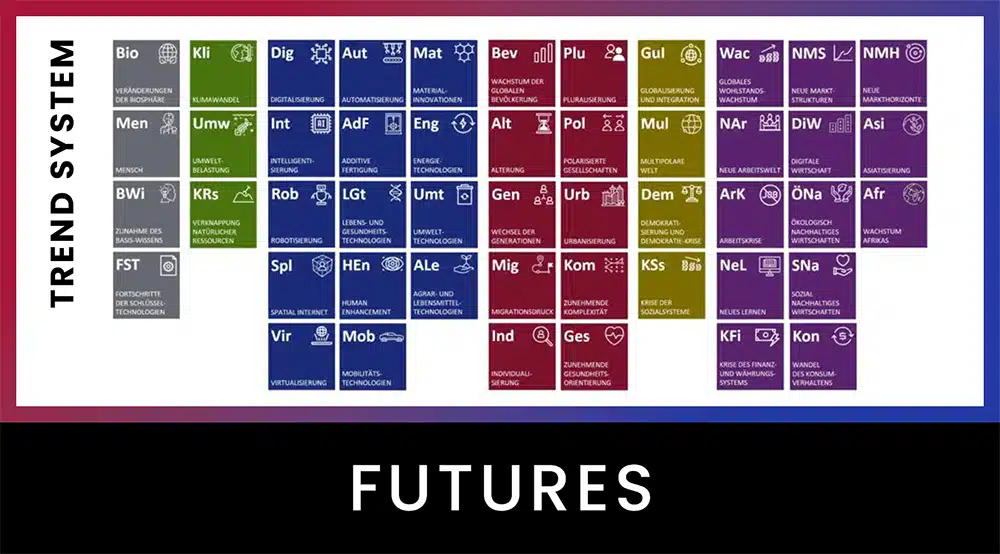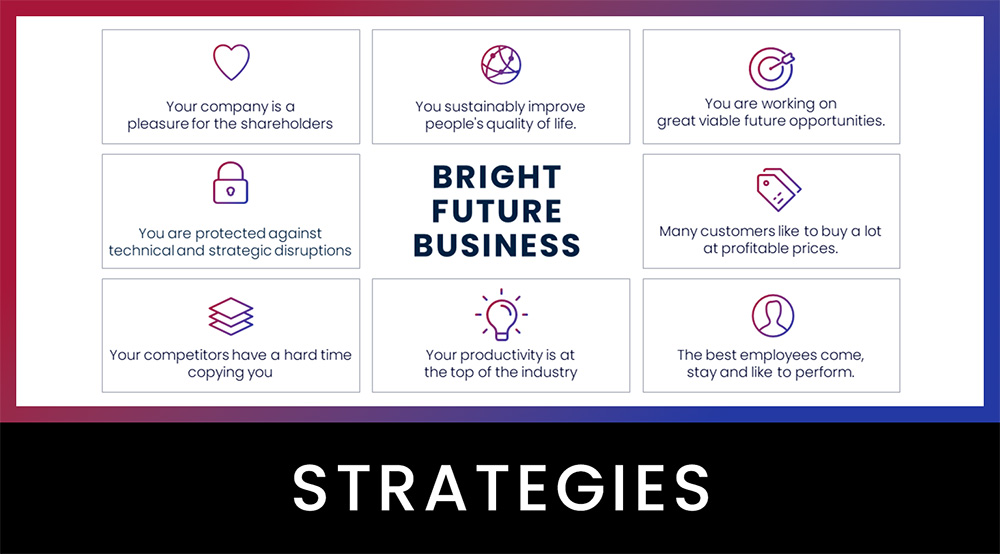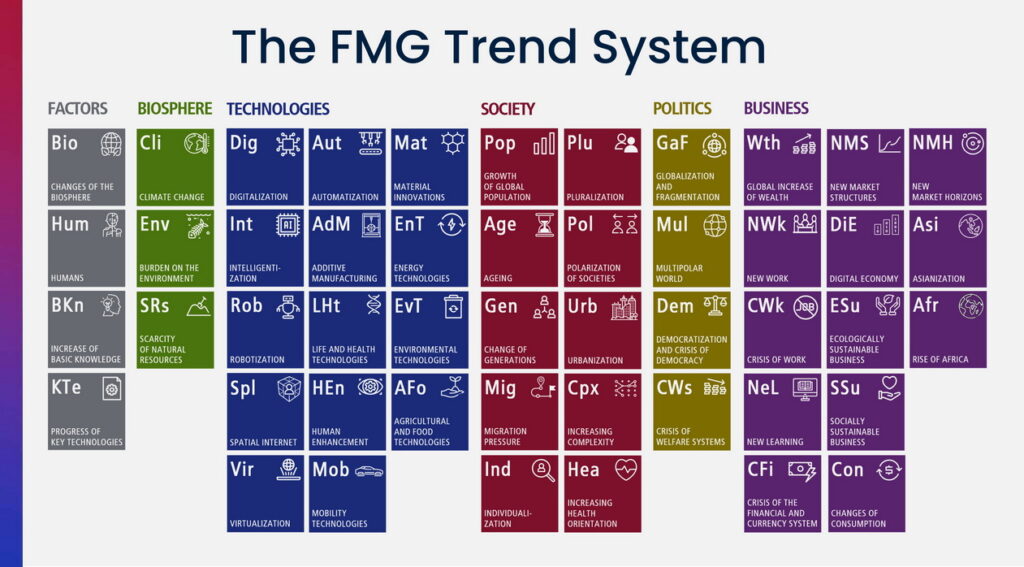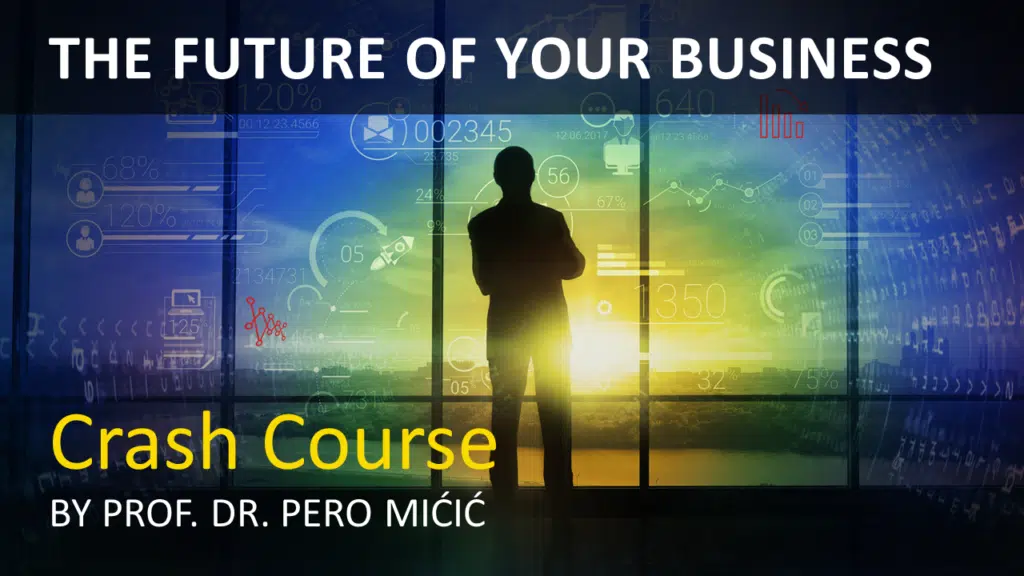Will AI and robotics lead to a poverty catastrophe or to prosperity for all?
Dr. Pero Mićić
How do you earn your money today? No matter what you answer. AI and intelligent robots will perform more and more human tasks. And better, faster and cheaper. Yours too. Many people will work much less or not at all in normal jobs. And earn less or nothing. But what will you live on then? What about your colleagues and employees? Do we coach the robots then? Or how do we pay for our living? And how are our companies supposed to survive? This is the central question of our time!
Come with me on a journey of insight into the future. Together, we look at three scenarios of the future living and economic world. If AI and robots work for us en masse, our future could be great. Highest quality of life, without work stress and more time for family, pleasure and hobbies. But things can also turn out quite differently. We could also wake up in a horror scenario.
Firstly, we humans are very short-sighted and not very future-oriented. And secondly, we have a huge and catastrophic flaw in our economic system that could lead to disaster in an AI and robotics world. Correcting it is the biggest challenge. You can find out which error this is in this article.
What does our future look like with AI and humanoid robots?
In recent months, I have published several articles on the future with AI and humanoid robots. I link to the posts at the end of the article Here is a compact summary of my messages:
- In just a few years, AI will surpass the intellectual performance of almost all humans. Most players in the AI world now largely agree that AI, which is more intelligent than all humans combined, is only a few years away.
- Humanoid robots will quickly surpass the physical capabilities of all humans. Smoother than Olympic athletes and with the dexterity of the world’s best surgeons. Precisely because they are modeled on the human body, their greatest advantage is their universal applicability. Your robot makes your garden beautiful, then cooks your dinner, irons the laundry afterwards, then plays with your children and tells them very personal bedtime stories. Without vacation, sick leave, bad days and lack of concentration.
- Humanoid robots are becoming superhumanly intelligent thanks to AI brains. They can think, talk to us, learn and be creative. This is no longer science fiction. In a year or two we will see thousands of them in the factories. Later many millions and even billions.
- The costs for the work of humanoid robots will be unrivaled. I have detailed the costs per working hour in an article. You can find the link at the end of the article. Initially around 14 euros, later 10 euros and in the medium to long term less than 5 euros per hour. And they do it all without complaining about working hours, calling the union about work-life balance or seeing a therapist about low self-esteem. This means that companies have no choice but to use humanoid robots in the face of competition.
- AI makes work more efficient and, above all, more productive. Quality of life and prosperity increase significantly, at least potentially.
- Intelligent robots will initially solve the global labor shortage. It is likely that in many developed countries the labor shortage will simply disappear.
- AI and intelligent robots will mean that many people will work less or no longer work. New jobs and tasks will not be created so quickly this time to compensate for the losses. This is because AI is developing so rapidly and because new jobs and tasks are also being created with AI support.
- In the long term, most people will earn significantly less or no income at all from working in traditional jobs. If you no longer earn any money, you won’t be able to buy food or pay your bills. A fatal downward spiral.
What happens to income in an AI and robotics economy?
What are the consequences of AI and robotics in today’s system if we don’t change it? You generate your own income from one or more of the following types of income.
1. work: salary as an employee or fee as a self-employed person
- In the medium to long term, up to 80% of the tasks currently performed by employees will be eliminated. Slightly less for the self-employed, because many of them can find and develop new fields of activity more easily than employees within their company.
- Some workers will have higher incomes than today for jobs that require particularly high and absolutely human qualifications. For example, the best strategic software developers, the best consultants or the best managers.
- In the past, we have repeatedly created new professions and jobs. Professions such as weavers, coachmen or stenotypists have disappeared, and yet we have not experienced mass unemployment because new industries, professions and tasks have always been created. This time too, there will be new jobs and tasks for people. Both in the field of AI and robotics and outside of it. But this time it will not be the case that practically as many new jobs and tasks will be created just as quickly as old ones are lost. There are three key differences this time:
- The change brought about by AI and robotics is so fast and so radical that the need for human labor is decreasing much faster than new jobs are being created.
- The new jobs and tasks are developed from the outset in such a way that people have to do as little as possible.
- Most people cannot develop their skills as quickly as the demands on human jobs increase. Unfortunately, for the time being, we can’t simply install an upgrade. Only robots can do that.
This is what distinguishes this change from previous technological revolutions. And that is what makes it so dangerous, despite all its advantages.
2. entrepreneurship: income from entrepreneurial activity
- If people’s incomes fall so sharply across the board, they can buy less. This leads to a drastic slump in sales and therefore company profits. They make huge losses and go bankrupt in droves.
- Prices will also rise for the particularly demanding services provided by companies. If they require high human qualifications.
- And there will be new business areas for companies. Directly in the field of AI and robotics and also outside of it. In the future, every business area will be driven by AI and robotics.
3. ownership of productive assets: income from investments, capital gains from company shares, income from rents and licenses
- Anyone with productive assets is also dependent on having customers, tenants, leaseholders and licensees. But if their income collapses, such earnings also plummet. Shares in companies, whether held directly or via shares, lose drastically in value. This also has an impact on private pensions. Real estate also loses drastically in value when rents can no longer be paid. A sale results in catastrophic losses.
4. ownership of unproductive assets: income from increases in the value of commodities, art or crypto tokens, interest on deposits or loans granted. I see money as an unproductive asset because interest at best compensates for inflation.
Unproductive assets also lose value. If there is much less demand, the value of commodities, art and presumably cryptocurrencies will also plummet. The situation is different with financial assets. As prices will fall sharply, cash will become an advantage.
5. income without benefits: Pensions and annuities, maintenance payments, transfer payments such as citizens’ allowance or housing benefit.
6. free services: transfer services such as free schools.
The non-performing income and services can only be paid and provided if the state has sufficient revenue. In many countries, pensions are paid from the contributions of people who are still working. Their incomes are collapsing, hence the payments to the pension insurance scheme. The state lacks the tax revenue to top up pensions from tax revenues. The state also lacks the money for social payments such as citizens’ allowance, housing benefit and child benefit. And, of course, those obliged to pay maintenance can also pay significantly less or nothing at all.
7. price effect: This is of course not a source of income, but the price level determines the purchasing power of your income. In other words, how much you can afford.
The only strongly positive factor is the price effect. When most incomes collapse, people buy less. There is an oversupply of products and services. Prices fall. This is economic deflation. There is also technical deflation. Products and services created with AI and robots will be significantly cheaper. Because the majority of personnel costs will be eliminated. What’s more, AI and robots can be scaled up very quickly. Just as we have seen with computers, monitors, solar cells and batteries for a long time. Then everything could cost just a fraction of today’s prices. That puts the loss of income into perspective. But not to the full extent.
How could this affect the economy and society? Three scenarios
Let’s imagine three scenarios for the next 10 to 20 years. You can consider which scenario you think is the most likely.
- The horror scenario: the state and the economy have done practically nothing effective. Society experiences an economic catastrophe.
- The crisis scenario: the state and the economy were able to prevent the horror scenario. However, a sharp decline is inevitable. Many nations will be too slow and too divided to act consistently. They will try to muddle through. But in doing so, they will fall behind and their citizens will become much poorer.
- The abundance scenario: the state and the economy make intelligent use of future opportunities and massively improve the quality of life of all citizens.
The horror scenario
We will experience this scenario if we do not change anything. If we don’t rethink work and income to counter the effects of AI and robotics. This is what happens in the horror scenario:
- Incomes and assets are falling massively. Falling prices are not enough. The state is collecting drastically less tax.
- Within a few years, an unprecedented level of mass poverty emerges.
- The situation is initially concealed by governments with expensive measures, which makes the crisis even worse.
- Everyone is fighting everyone else. Extremism and belief in conspiracies are on the rise. The guilty are identified and fought against. We are falling back into a Stone Age society in a state of nature.
- Citizens elect radical parties to parliamentary majorities. Or they start a violent revolution.
- Totalitarian regimes and strong leaders seize power. In some countries from the left, in others from the right. They nationalize practically everything. Strong leaders determine what happens. Everything is brought into line. Products and services are rationed and allocated. The government determines what companies produce and at what price. As is so often the case, some ethnic group is blamed for the catastrophe and fought against politically and privately. Whether far-right fascism or far-left communism. Freedom is dying.
Could it really turn into a horror scenario?
It is possible and it is also plausible. If we act stupidly, irrationally, too little and too late. The horror scenario will not happen overnight. But when it does, it will happen faster than we would all like.
There are historical examples of this. At the beginning of the 19th century, textile workers tried to stop the industrialization and abolition of their jobs by storming the factories and destroying the looms, knitting machines and spinning machines. This led to a series of revolutions in Europe from March 1848 onwards. In France, Germany and Italy, among others. These were very painful and life-threatening decades.
Do I think the horror scenario will happen? Not necessarily. Most countries will do something about it. But probably too little and too late. Because governments, like all people, are very short-sighted and therefore often stupid about the future.
Why don’t we simply stop this development?
Technological change can never be stopped permanently. In the 1980s, one German party refused to use computers in its Bundestag offices. Because they considered them to be an imperialist tool of exploitation. We will also not prevent the very rapid development and spread of AI and intelligent robots and their effects. Simply because their benefits are so great and their costs are so low. Even if we try to coordinate it globally. We won’t be able to convince the Chinese, for example, to give up AI and robotics that are superior to humans. Because they want economic strength and they have to cope with the shrinking of their population from now on. We cannot stop the change. And it would be rather harmful for us if we tried. Because, as I said, sooner or later we will be living in abundance thanks to AI and robots.
The crisis scenario
The crisis scenario is largely self-explanatory. It is tough, but not quite as bad as the horror scenario. But it is a far cry from the abundance scenario.
The abundance scenario
The abundance scenario with a massive increase in everyone’s quality of life can become a reality. Above all, we need to correct a crucial flaw in our economic system.
What’s the mistake, you ask? It lies in the fact that our entire global economy is organized in such a way that over 90 percent of people sell their mental and physical labour as employees in order to generate income. Almost without exception, they are paid by the hour with a monthly salary. Company owners, on the other hand, can replace the work of their employees with AI and robots. They have to, because their competitors in China and elsewhere will do the same. They can and will benefit from the higher productivity. As a rule, employees do not have this option. They would only have them if they were paid according to their productivity when using AI and robotics. Or even better, if they themselves become entrepreneurs or partners in companies.
- If an economy shaped by AI and robotics is to bring more quality of life and prosperity for everyone, then we must ensure that everyone benefits from the advantages in terms of efficiency and productivity. And we can achieve this by ensuring that as many people as possible become owners of productive assets. We will look at how exactly in the next, second part of this article.
- The high efficiency of AI and robotics drastically reduces the cost of living. A kilometer in a robotaxi for 20 cents will be cheaper than bus and train and the luxury coffee at Starbucks will only cost 50 cents. The prices for every product and every service are largely made up of the salaries of the people who worked on them. Most of this would be eliminated because AI and robots work faster and cheaper than humans.
- AI and robotics will not only make us more efficient, but also far more productive. Productivity means that we can create many more benefits for people with existing resources and our time. History has also proven this. Almost all of us have a quality of life that was unimaginable for most people just a hundred years ago. The potential for greater productivity is much greater than the potential for greater efficiency in today’s system.
- The innovative power greatly enhanced by AI is helping to solve key problems facing humanity.
- We will find preventions and therapies for all types of cancer and many other diseases more quickly.
- We will develop new materials. The Google AI DeepMind has developed 380,000 new materials in just a few weeks. Without AI, it would have taken us several hundred years.
- We will develop new energy systems, make difficult sources such as geothermal energy simpler and significantly increase the efficiency of solar cells. Energy will become affordable and sustainable.
- We could even find effective ways to stop and reverse the human impact on the climate.
- Countless new professions, jobs and business areas will emerge. AI and robots will handle processes automatically. But the new tasks of humans will primarily be in direct service to people. We can take far more care of each other and be there for each other.
- If we manage to make the transition from today’s economic system to a new one in a reasonably intelligent way, people around the world will live in the best of health and in abundance. When people live in abundance, we also have the chance of lasting peace. This is because wars and conflicts are practically always waged out of greed and over scarce resources.
We have a historic opportunity to create a life of prosperity and health for everyone. Just as the super-rich do today. And without harming the biosphere or other people.
Quality of life is the only thing that can continue to grow forever. To achieve this, we don’t have to consume more and more resources, damage the environment and stress ourselves more and more. AI and robotics will bring us ever closer to a fully circular economy without waste and without the exploitation of resources. Useful innovation and productivity are the most important factors for the prosperity of a person, a company and a state. AI and robotics are here to do just that.
In the very long term, every nation and society will ultimately live in a scenario of abundance. That is the beauty and positive aspect of it. But after all experience with the less than future-intelligent behavior of many governments and yes, also of voters, only some of the states will manage to save their citizens from the valley of tears on the way to the abundance scenario.
Summary: And now?
I hope I have been able to make it clear what unimaginably huge changes lie ahead of us. This is not science fiction. It has already begun.
However, it is quite possible that we will experience all three scenarios one after the other. First the crisis scenario, then the horror scenario. And finally the abundance scenario, if governments, companies and citizens act in a truly future-oriented way.
Everyone will be affected and involved. You too. Think about what you can do today to prepare for these changes. And even profit from it. We will think about this together in the next article.
The opportunity for the abundance scenario is tangible and real. If, yes IF, we make it possible for everyone to benefit from AI and robotics. To do this, we will have to change our economic system. No, not towards socialism. The right economic system for the future will not be characterized by scarcity, restriction and distribution. On the contrary. It will be a system with the greatest imaginable freedom and quality of life.
We’ll think through this together in part 2, which you can find here. I’ll also show you what you can do today to make yourself more future-proof.
Have a bright future!
If you want regular practical tips and strategies for your future management, free of charge, become a member of our “Bright Future Leaders” community.
Here you can find the other articles on AI and robotics:
– Humanoid robots: the solution to the labor shortage? (Part 1)
– Humanoid robots: will they be intelligent enough? (Part 2)
– Humanoid robots: how will they learn? (Part 3)
– Humanoid robots: how much will they cost? (Part 4)
– Prosperity through AI, but how? (Part 2)


































